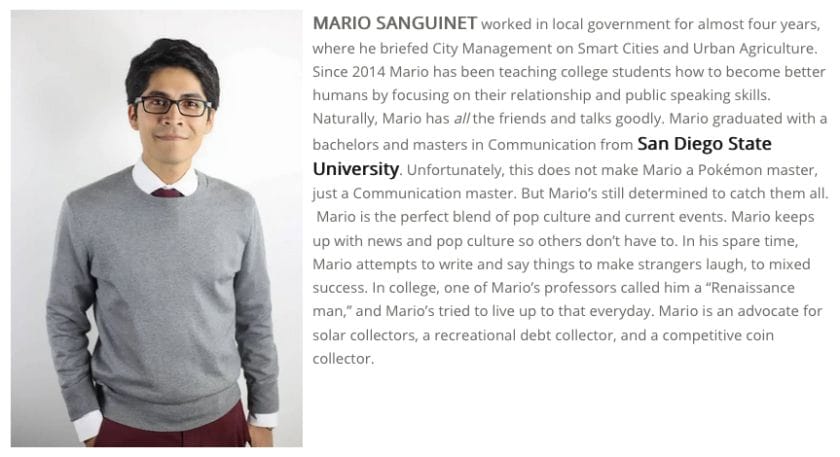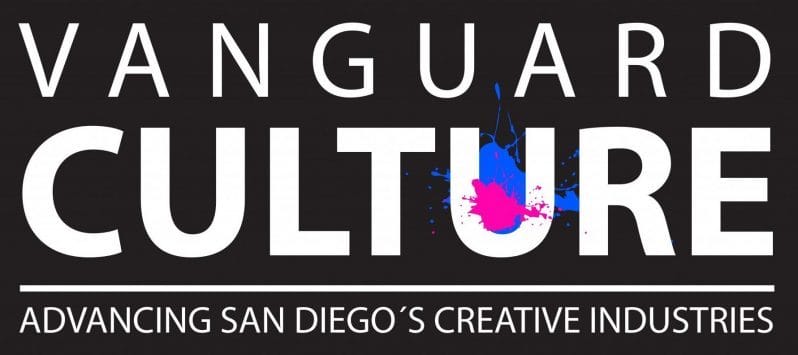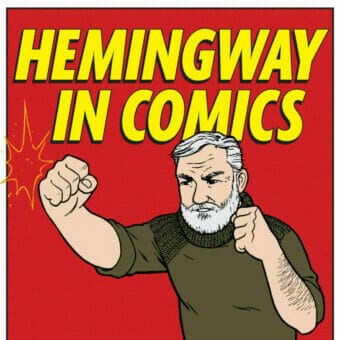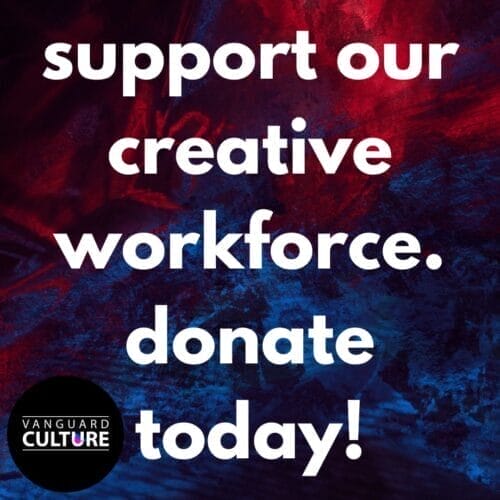Mario Sanguinet
December 15, 2022
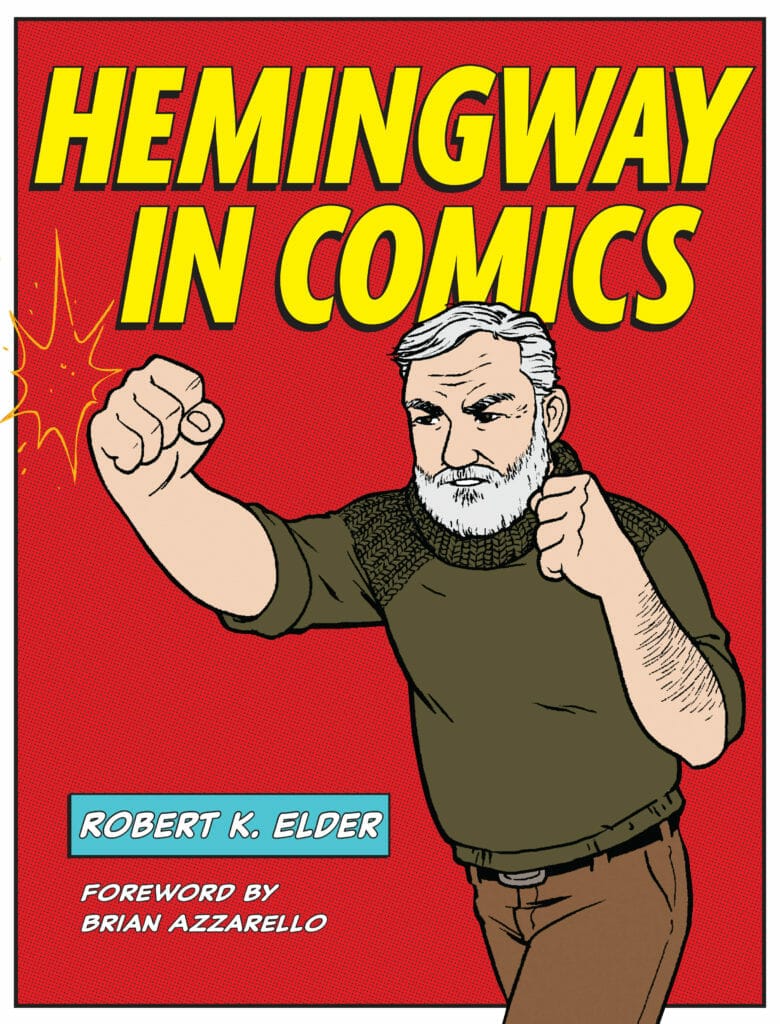
On Nov. 26, 2022, San Diego Comic Con Museum celebrated its one year anniversary. Among the exhibitions it currently houses is an exploration on famed US author, Ernest Hemingway and his appearance in comic books from 18 countries worldwide.
The exhibit takes a look at what it means to be an icon and how that perception changes over time. Now on display on the museum’s upper level, the exhibit includes 40 works of art from artists, including Chris Ware, Colleen Doran, Cliff Chiang, Steve Rolston, Ryan Inzana, Gabo, Norwegian artist Jason, and many others.
Robert K. Elder, wrote “Hemingway in Comics,” which documents over 120 Ernest Hemingway “cameos” in comics from 18 countries around the world, including the U.S., Mexico, Netherlands, and Latvia. He will be giving a talk on his book on Dec. 17, 2022 at the San Diego Comic Con Museum. All those in attendance should “be prepared to have their minds blown.”
I recently spoke with Elder over the phone about his book, the lessons he learned from it, and what he hopes people bring with them and take away. The interview has been edited for length and clarity.
Mario Sanguinet – Can you tell me a little bit more like what was the thought or the impetus behind Hemingway in Comics?
Robert K. Elder – So I wrote a book called “Hemingway in Comics.” It came out during the pandemic and it was published by Kent State University Press. And the book tracks and examines the 120 plus times that Hemingway shows up as a comic book character, across the globe. I think I have, like 17 or 18 countries, everything from Italy, to Croatia, to Latvia. And a bunch from the US.
Hemingway has shown up in everything from Wolverine comic books to Italian Mickey Mouse comic books. He’s even, I think, in 1970s Superman comic books. The book and the exhibit are an examination of what it’s like to be a literary legend, and then lose control of that legend. It’s a sort of an examination of pop culture and what it means to be an icon.
MS – I want to follow up on the Mickey Mouse pieces, because I had the opportunity to walk through the exhibition and those stuck out to me.
RKE – So the Mickey Mouse one that you saw is from Topo Lino, which is Mickey’s name in Italian. And it’s from a self-titled magazine that they still publish their magazine. And it’s a whole bunch of comics and European comics about and with Disney characters.
One of the things I did not know is that when Disney licenses their characters overseas, there are a whole bunch of original stories that are never translated into English. So, I’ve been working with Fantagraphics publisher for a few months and we’re bringing those stories out for English reading audiences in March. So that’s going to be a lot of fun.
MS -Okay, now let’s get back to the Hemingway in Comics. Out of all the authors that you could have done this on, why Hemingway in particular?
RKE – Well, he’s the only one you could do it on. There aren’t that many other authors who show up with such prominence. Partially because of Hemingway’s stature. Several artists told me—especially a guy named Ruben Bolling, who does a comic strip called Tom, the dancing bug—that Hemingway has just become shorthand for famous American author. And so it’s a really interesting look at why people chose him because his presence in comics is really a different experience depending on who was writing about him.
Sometimes he is this boozed up brawler sort of figure. Other times, he is a sensitive writer who is a little sad. Sometimes he’s a gun toting intergalactic agents. There aren’t many other figures you can do this with. For instance, F. Scott Fitzgerald shows up a few times in some of these comics, but very seldom on his own. James Joyce shows up a little bit. But I did sort of an accounting of historical figures and the second most cameos after Hemingway was Abraham Lincoln.
MS – That’s really interesting. What propelled you to go down this path and look into which author was the most covered across the popular arts?
RKE – Well, I live in Oak Park, Illinois, which is Hemingway’s hometown. And I was the Editor in Chief of a newspaper, The Oak Leaves, which he delivered as a kid. I had written a book called Hidden Hemingway, which is about the archives inside Oak Park. And when you promote the book, you sort of do other things that are ancillary.
So because I love comic books and when I was a teenager, I worked in a comic book store, the Wizards Workshop in Billings, Montana. When I was thinking about places that might be interesting to write about, I thought: “Hemingway shows up in a lot of weird comics, it might be fun to do a little examination of this for the Comics Journal,” which is the go to place for comics, scholarship, and comics writing. So I wrote one piece, and that turned into a second piece. And that just kind of kept snowballing. In the middle of this I had given a talk about my comic book findings at the International Hemingway Conference, which that year happened to be in Oak Park.
After that people kept inviting me to give this speech all over because it was a multimedia speech and it’s fun. And scholars love a lot of self-referential, meta subject matter. And comic books now are not only their big business, but it is the centerpiece of a lot of culture in a way that it wasn’t for years. But I have always said that comic books are a great American art form, just like baseball and jazz.
MS – Right. So you’re going to be coming to San Diego on December 17th. Are you giving the same talk? Or how will this talk be different?
RKE – I’m giving a much-expanded talk. It’s a multimedia talk. I have slides so you can see what I’m talking about. It’s meant to be fun and educational. It’s directed at families, but depending on who I see in the audience, there are some things that are naughtier than others. But, I think it’s going to be a lot of fun. And as a comic book fan—who loves San Diego Comic Con—it was such a big deal for me to be invited and to be part of the inaugural set of exhibits to go up in the Comic Con Museum.
During Comic Con there was a preview and I got to take my family to the Comic Con Museum. And it was a really interesting experience, because I was there with other big exhibits, like Archie, Spider-Man, and Dave Stevens’ The Rocketeer. And for me to be in that company was just sort of a dream come true.
MS – How did you pick which pieces made it, what was left on the cutting room floor, and what judgment calls were made in that process?
RKE – A lot. I mean, a lot did not make it in. In fact, I think what you’re seeing is, maybe, maybe less than half of my entire collection of Hemingway related stuff. We went for a wide variety of representation, as many different countries as I can get. There’s a page from Nathan Never, which is from Italy. There’s also the Mickey things from Italy. There’s a page from some Nordic countries. But the goal was to have the widest variety, so you can see the breadth and different characterizations of Hemingway throughout all these comments.
MS – What’s something that you learned in the process of putting this book together?
RKE – A couple of things. One is this really interesting insight into Hemingway’s gender identity. So many scholars have written about this, it’s a little bit better known now. But he had sort of an interesting and complicated gender identity. And later in life, sort of did gender swapping with his wife, Mary. He often wanted to be called Catherine and he called her Peter. So that is sometimes reflected in the work.
But the thing that I take away most is this idea of when you become larger than life and you lose control of your myth. Is that a good or a bad thing? When you are boiled down to the essential parts of your myth, is that reflective in any way of who you are? So that’s the question that I sort of keep coming back to.
MS – Okay. So my next question is: what has working on this book taught you about the human condition?
RKE – It taught me… Let me see… Well, I’m not the first person to say this, I think other people have said this, but there is more than one Hemingway. People’s vision of him and experience with his words, which was truly revolutionary, especially in the 1920s. And he has shaped the way that writers write in a very real way. His influence on a generation of writers—on a century of writers—is palpable. But it has helped me have empathy for someone who can be kind of hard to have empathy for because he was a difficult dude and not always someone who was sympathetic. Now, as you get to know him more and understand his struggles and his personal demons, it’s much easier. But it helped me have empathy for a really complicated figure.
MS – What’s one thing that you would like the San Diego audience to know about the book before they come and see you?
RKE – I would want them to consider what they bring to the table. Because one of the things Hemingway believed in was this Iceberg Theory: if you were to leave something out, the reader would know it was there.
In other words, you bring your own interpretation to surface level descriptions, and the interaction between the writer, the page, and the reader is important. So not only are there many different kinds of Hemingway, and different versions of Hemingway, there are different ways to read Hemingway. So I would ask audiences to come with a little bit of self-analysis and ask themselves what sort of assumptions they’re bringing to Hemingway, and maybe be prepared to have their minds blown.
MS – What do you want people to walk away with, either after coming to your talk, or reading your book?
RKE – I want them to be interested enough to seek out some of the work I’m highlighting, and have a deeper appreciation of this kinship that I believe exists between comic book creators in Hemingway. Because Hemingway was about an economy of words and telling the most powerful story in the fewest amount of words. And that is the exact same thing that comic book creators are trying to do. You can only fit so many images in so many words on a single comic book page. So, I think there’s this very natural connection that comic creators and Hemingway share.

